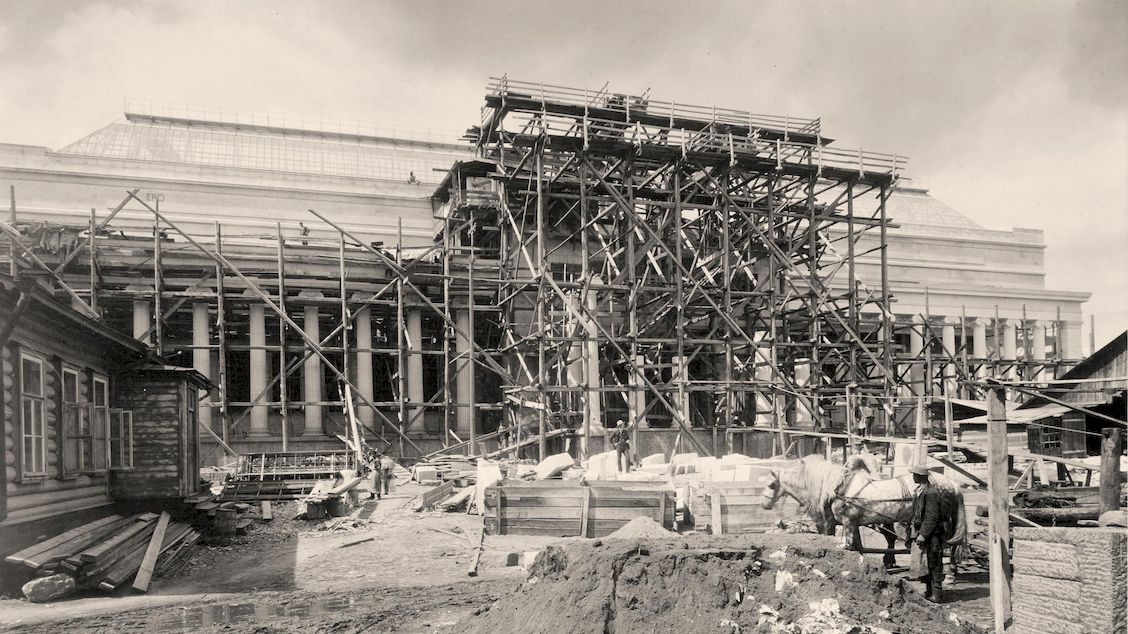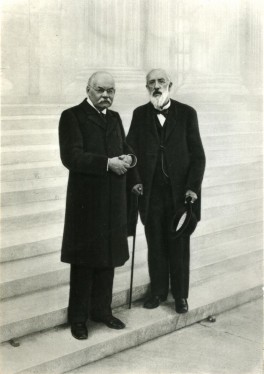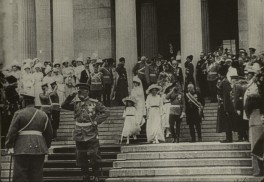In order to organize a museum affiliated to Moscow University, a special Committee for the Establishment of the Alexander III Museum of Fine Arts started to function in 1898. It had been envisaged as a voluntary association of individuals keen to play an active part in the systematic propagation of academic knowledge in the field of fine arts among wide strata of Russian society. It brought together leading figures from the University, professors from the History and Philology Faculty, top representatives of the city's administration and private individuals, who were contributing funds for establishing the Museum or donating works for it to display. The Committee was set up so as to function while the Museum was being built, but in practice it continued to exist until February 1917.From the moment the Committee was inaugurated until his assassination in February 1905, it was chaired by Grand Duke Sergei Alexandrovich (1857-1905). As early as 1854, he came forward as a patron of the University's museum. His report delivered in July 1895 announced the decision taken by Nicholas II to delay the stone-laying ceremony for the building of the Industrial and Technical Training School in Kolmazh Court – planned as a commemoration of the Silver Jubilee of Alexander II's accession, so as to clear the site for the new museum. In 1898 the whole site was set aside for the new construction project. That same year, thanks to the efforts of the Grand Duke, 200,000 roubles were allocated from the State Treasury to the construction of the museum. At the expense of the Deputy Chairman of the Committee, Yuri Stepanovich Nechaev-Maltsov (1834-1913) – a leading industrialist and courtier – white frost-resistant marble was quarried and brought to Moscow from the Urals for the facing of the Museum's façade and colonnade. Nechaev-Maltsov also financed the granite base-platform and steps leading up to the entrance and the coloured marbles for the main staircase. In addition, Y.S. Nechaev-Maltsov acquired the first original works of art and cultural artefacts from Ancient Egypt for the Museum. Thanks to him, the Museum acquired a whole series of valuable copies of artworks of antiquity famous the world over. All in all Nechaev-Maltsov contributed two million roubles to the construction of the Museum and the assembly of its collection (two thirds of the total cost).
The Secretary of the Committee and its actual organiser was art-historian Ivan Vladimirovich Tsvetaev, a professor from the department for the theory and history of art at Moscow University with a doctorate in Roman literature.
The starting point for the Museum's collection had been Moscow University's "Cabinet" (Museum) of Fine Arts and Antiquities, which included Greek vases, a numismatic collection, a number of casts taken from works of Classical sculpture and a small specialist library. After Professor Tsvetaev had been appointed head of this "Cabinet", he began to expand the collection systematically, in particular its sculpture section and library. By such means he turned it into a Museum of Fine Arts at the disposal of students for educational purposes and of the public at large, where plaster casts, models and galvano copies in the context of a single and integrated academic programme were designed to introduce students and visitors to the main stages in the history of art from ancient civilizations up until the 16th century and this would make the Moscow museum the first institution of its kind.
Since 1881 the sculpture collection of Moscow University's "Cabinet" had been housed in two rooms of the former hospital block of the University. Despite the cramped and shabby nature of the premises in 1894, this small museum intended for students was made accessible, not just to students of Classics, but also for art lovers in general. In 1898, however, when the building was demolished, the collection had to be removed. Subsequently all the collections from Moscow University's "Cabinet" were transferred to the new Museum of Fine Arts on Volkhonka Street.
Tsvetaev ordered casts and other copies moulded directly from original art works in workshops abroad. In several cases these were the first such copies to be made. The most representative collection of such casts and copies was that of Greek and Roman art, in particular, sculpture. The collection reflected what were then the latest archaeological discoveries and scientific reconstructions of works of sculpture. The art of the Middle Ages, the Italian and Northern Renaissance, presented to the Russian public for the first time, constituted separate sections of the Museum's display. Many works exhibited in the Museum using high-quality casts and copies were a revelation for art-lovers and artists, if for no other reason than that they were depictions of the originals with their actual dimensions. One of the jewels of the Museum's collection was its unique collection of original works of Ancient Egyptian art and cultural artefacts (over 6,000 in total). The collection assembled by the Russian scholar and Egyptologist, V.S.Golenishchev was acquired by the state and transferred to the Museum in 1909-1911. Shortly before the Museum opened, M.S.Shchekin donated Italian paintings and works of applied art from the 13th-15th centuries and Grand Duchess Yelizaveta Fyodorovna and D.V.Khomyakov presented the Museum with its first original works of Italian sculpture of the 16th-18th centuries. Other donors also made major contributions to the Museum's collection.
While creating the Museum, Professor Tsvetaev consulted the artists Viktor Vasnetsov, Vasilii Polenov and many others. When it came to foreign scholars, the leading authority for Tsvetaev was the German archaeologist and director of the sculpture department in Dresden's Royal Museums, Georg Trei. The first members of the Museum's staff were Professor V.K.Malmberg from Moscow University (who succeeded Professor Tsvetaev as Director after the latter's death) and the orientalist, B.A.Turaev, from St. Petersburg who set up the first display in the Egyptian and Babylonian-Assyrian Galleries and also former graduates from Moscow University – A.V.Nazarevskii and N.A.Shcherbakov, who were appointed as curators - and Tsvetaev's students straight after graduation working as unpaid trainees - A.N.Zograf, D.S.Nedovich and A.A.Sidorov.
Professor Tsvetaev's establishment of an art museum led Moscow University to set up a subsidiary art-history department – the first of its kind in Russia – which in 1909 was to become an independent entity.
The Alexander III Museum of Fine Arts opened with grand celebrations on May 31 (June 13), 1912. Emperor Nicholas II and the Dowager Empress Maria Fyodorovna attended the ceremony.
Ivan Vladimirovich Tsvetaev was the Museum's director between 1911 and the day he died.
The new museum was popular with the general public right from the start. On weekdays between 700 and 800 people would visit and on Sundays and public holidays as many as 2,500. The majority of the visitors were teachers and gymnasium pupils, young women attending higher-education courses, students from the Moscow Archaeological Institute and members of the clergy. Special lessons for students and guided tours for the general public were organized in the Museum's galleries.
In 1923 it was decided by the People's Commissar for Education that a central museum illustrating the history of western painting should be established, housed in the building of the Museum of Fine Arts, which was no longer to be affiliated to the University. In 1924 pictures from the former collections of G.A.Brokar, D.I.Shchukin, from the State Museum Repository and various Leningrad Museums were acquired by the Museum of Fine Arts. This made it possible for the Museum's specialist staff, headed by Professor N.I.Romanov, to create a new exhibition of painting arranged in accordance with scientific principles and this was opened on November 10, 1924.
Between 1924 and 1930 the Museum acquired a large number of pictures from nationalized Moscow estates, from the Ostroukhov Museum of Painting and Icon-Painting, from the Historical Museum, the Kremlin Museum and the Tretyakov Gallery – works of West-European art from periods not previously represented in its galleries. Some pictures were also transferred from the Hermitage, other Leningrad museums and the Leningrad Museum Repository. Gradually the Museum came to possess a core collection for its Picture Gallery of Western Old Masters. By this time the Museum had also acquired over 1,000 cuneiform tablets and approximately 3,000 other Ancient-Egyptian objects from the former Museum and Research Institute of the Classical Orient.
In 1932 the Museum was renamed the State Museum of Fine Arts and in 1937 the name of Alexander Pushkin was added to its full title – the Pushkin State Museum of Fine Arts.
In 1941-1944 a large proportion of the Museum's contents was evacuated to Novosibirsk and Solikamsk. Restoration of the Museum building, which had suffered from bombing raids during the war, began in 1944 and work also started on preparing the displays once more for the public (the Museum finally re-opened on October 3, 1946) under the supervision of the then director, the sculptor S.D.Merkulov, Professor B.R.Vipper, the Deputy Director responsible for academic issues, and the Chief Curator, A.A.Guber. Work began again aimed at making the museum and its contents better known to the general public and at expanding both its collection and its involvement in archaeological excavations in the Crimea and the Taman Peninsula, which had started back in 1927.
Apart from regular archaeological expeditions to the North Pontic region in the period 1951 to 1973, the Pushkin State Museum of Fine Arts also participated in the work of the Transcaucasian Archaeological Expedition within the territory of Ancient Erebuni together with the Institute of Archaeology of the Armenian SSR and the State Hermitage Museum: some of the works of Urartu art and the cultural artefacts discovered during those excavations are held in the Museum's repositories.
In 1948, when the State Museum of New Western Art was closed and the items in its collection were re-distributed between Moscow and Leningrad, the Museum acquired around 300 paintings and over 60 works of sculpture by West-European and American artists of the late 19th century and the first third of the 20th. The majority of the works concerned were those of French Impressionists and Post-Impressionists, which had belonged to the Moscow collectors Ivan Morozov and Sergei Shchukin, and the Museum also acquired that museum's collection of drawings and its archive materials. This acquisition meant that the range of the Museum's collections extended as far as the 20th century, which at the same time made it more famous.
Between the end of 1949 and 1953 the Museum's galleries were used to house exhibitions of Gifts presented to Joseph Stalin. On December 15, 1953, however, the permanent exhibition of art was rearranged as before. Over the whole period of the Museum's existence it has hosted over 1,200 exhibitions consisting both of works from the Museum's own repositories and also works from many other collections from within our own country and from abroad.
A major event in the cultural life of Moscow was the opening, in the Pushkin State Museum of Fine Arts, of an exhibition of masterpieces from the Dresden Art Gallery, which had been saved from destruction by Soviet soldiers during World War II. In 1958 and then again in 1995-2007 exhibitions were held in the SMII entitled "Works of Art from the Museums of the German Democratic Republic", "Exhibition of European Paintings – 14th-19th centuries", "Five Centuries of European Drawings. Drawings by Old Masters from the former collection of Franz König", "Trojan Treasures from the excavations of Heinrich Schliemann" and so on.
In 1985, on the initiative of the Soviet collector, Doctor of Art History, I. S.Zilberman, and the Museum's director, I.A.Antonova, a special Department of Private Collections was set up. The idea behind this department was an innovation within the museum world: for the first time collections themselves, rather than individual works from collections, provided a focus of study and 'items' for museums to collect. The exhibition in this new department was opened to the public in a specially reconstructed building on January 24, 1994.
At the present time the Pushkin State Museum of Fine Arts houses four types of exhibitions:
(1) an exhibition of casts made from works of sculpture and architectural monuments which has remained substantially the same as it was when the Museum was still affiliated to Moscow University, including casts of works from the Near East, the Classical world, the Middle Ages and the Italian and Northern Renaissance;
(2) a section containing original works of art and cultural artefacts from Ancient Civilizations and also materials from excavations organized by the Museum;
(3) a gallery of pictures from the 8th to the 20th century, including works by European Old Masters, Byzantine icons and ancient mosaics and works by West-European and American painters and sculptors of the 19th and 20th centuries. The principle behind this exhibition was to demonstrate the nature of national schools of painting and the succession of one era after another in the world of art;
(4) the last type is that of the Department of Private Collections, in which each collection is an integral artistic and cultural phenomenon in its own right, which sheds light on the personality of the individual collector.
In 2006 a Centre for the Aesthetic Education of Children and Young People was opened in what had once been a private house in the immediate vicinity of the Museum and which came to be known as the "Museion".
In August of that same year work began on a significant expansion of the exhibition of the Museum's paintings and sculpture from the 19th and 20th centuries. The building concerned is known as the "Gallery of Art from the Countries of Europe and America – 19th and 20th centuries".
The Museum also has departments in other parts of Moscow. In 1996 a Tsvetaev Educational Art Museum was installed in the building of the Russian State University for the Humanities. It opened on May 30, 1997 (at 15, Chayanov Street). It houses plaster casts from the original museum, which had been part of Moscow University, as well as some duplicates of the latter.
In 1961, in response to a proposal from the pianist Svyatoslav Richter and with his active involvement, the Museum began to hold within its walls an international musical festival known as "December Evenings" and, after 1997, as the "Svyatoslav Richter December Evenings". In 1999, in accordance with the musician's last will and testament, his flat (Flat 58, 2/6 Bolshaya Bronnaya Street) was bequeathed to the Museum and this memorial to him is now open to visitors.
At the present time the collection of the Pushkin State Museum of Fine Arts comprises over 670,000 paintings, works of sculpture, drawings, works of applied art, archaeological artefacts, coins and medals and art photographs. Its repository of manuscripts contains documents relating to the history of the Museum, academic works and letters written by the Museum's founder, by other leading lights of the Museum and well known art-historians and artists and, also, archive materials from several museums whose collections were transferred to the Pushkin Museum.
The Museum has its own restoration workshops and one of Moscow's finest specialist academic libraries.
In 1991 the Pushkin State Museum of Fine Arts was added to the state register of particularly valuable institutions constituting the cultural heritage of the peoples of the Russian Federation.







